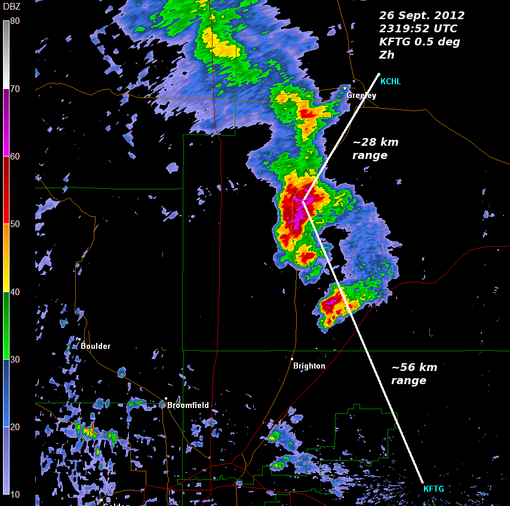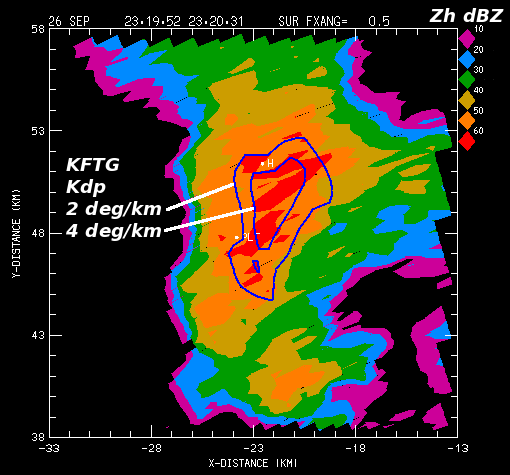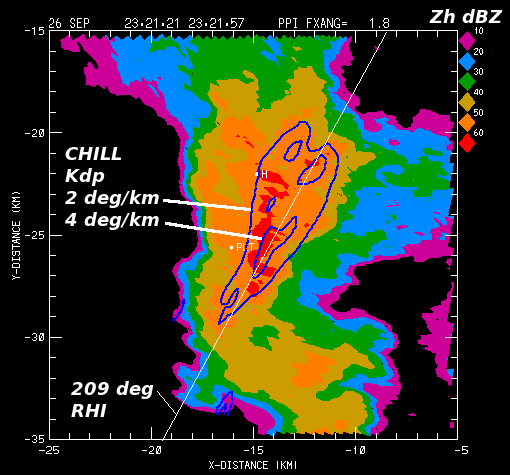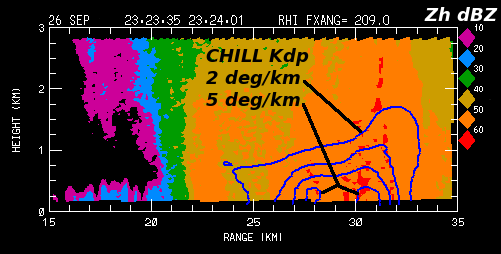A comparison of dual polarization KFTG and CSU-CHILL Kdp fields: 26 September 2012
Introduction
The Denver / Front Range WSR-88D radar began operations in dual polarization configuration on 5 September 2012. One of the first opportunities for KFTG to collect dual polarization data in severe convection occurred on 26 September when thunderstorms producing locally heavy rain and small hail developed in the area. The CSU-CHILL radar was also operating on the afternoon of the 26th. CSU-CHILL was operating in alternating H,V transmission mode at a significantly slower azimuthal scan rate (~8 deg / sec). Due to the difference in scan rates, CSU-CHILL used PPI sector scans to allow more sweeps to be completed within the ~4 minute duration KFTG volumes. Periodically, the CSU-CHILL volumes were manually started in an effort to attain time synchronization with KFTG. The following plots were made from volumes scans that KFTG started at 2319:52 UTC and CSU-CHILL started at 2319:32 UTC. The following plot shows the KFTG reflectivity field at the 0.5 deg elevation angle. The storm of interest was located just northeast of Platteville at this time.

KFTG data
The level II KFTG data for this event was obtained from the National Climatic Data Center (NCDC). Specific differential propagation phase (Kdp) was calculated from the basic propagation differential phase (PH) data in the level II file using the methods of Wang and Chandrasekar (JTEC, Dec, 2009). In the following plot, the KFTG Kdp values are shown as solid contours overlaid on a color fill depiction of the reflectivity field. "PLT" indicates the location of the town of Platteville. Kdp values exceeding 4 deg / km (implying rain rates of ~130 mm / hr) were present in the area immediately northeast of Platteville. Public reports of localized flooding and sub-severe (less than 1 inch diameter) hail were received from Platteville. (Near 0 dB Zdr values indicative of hail were present in the CSU-CHILL data at the "H" location ~5 km north of PLT).

CSU-CHILL PPI data
The center of the KFTG beam was at a height of ~2.35 km MSL in the high Kdp area. Due to the closer range and lower site elevation (1.42 km vs. 1.68 km), an elevation angle of 1.8 degrees was required to observe the ~2.35 km height level from the CSU-CHILL radar. The following plot shows the overlaid Kdp / reflectivity color plot of the CSU-CHILL data at the 1.8 deg elevation angle. Due to the shorter range and lower side lobe level antenna, smaller scale features are present in the CSU-CHILL Kdp field. The general Kdp magnitudes observed by KFTG and CSU-CHILL are in reasonably good agreement.

CSU-CHILL RHI data
Shortly after the PPI scans shown above, an RHI scan was done by the CSU-CHILL radar on the 209 deg azimuth to observe the vertical structure of the high Kdp area. As shown in the following plot, the Kdp magnitudes increased significantly within ~1 km of the ground. This was probably the result of enhanced drop production from hailstones that were both shedding liquid and / or completely melting.

Summary
Kdp data is critical in the development of accurate rain rate estimates when mixtures of rain and hail are present. Based on this simple "snapshot" examination, fairly good agreement was found between the Kdp values observed by the operational KFTG radar and the CSU-CHILL research radar.